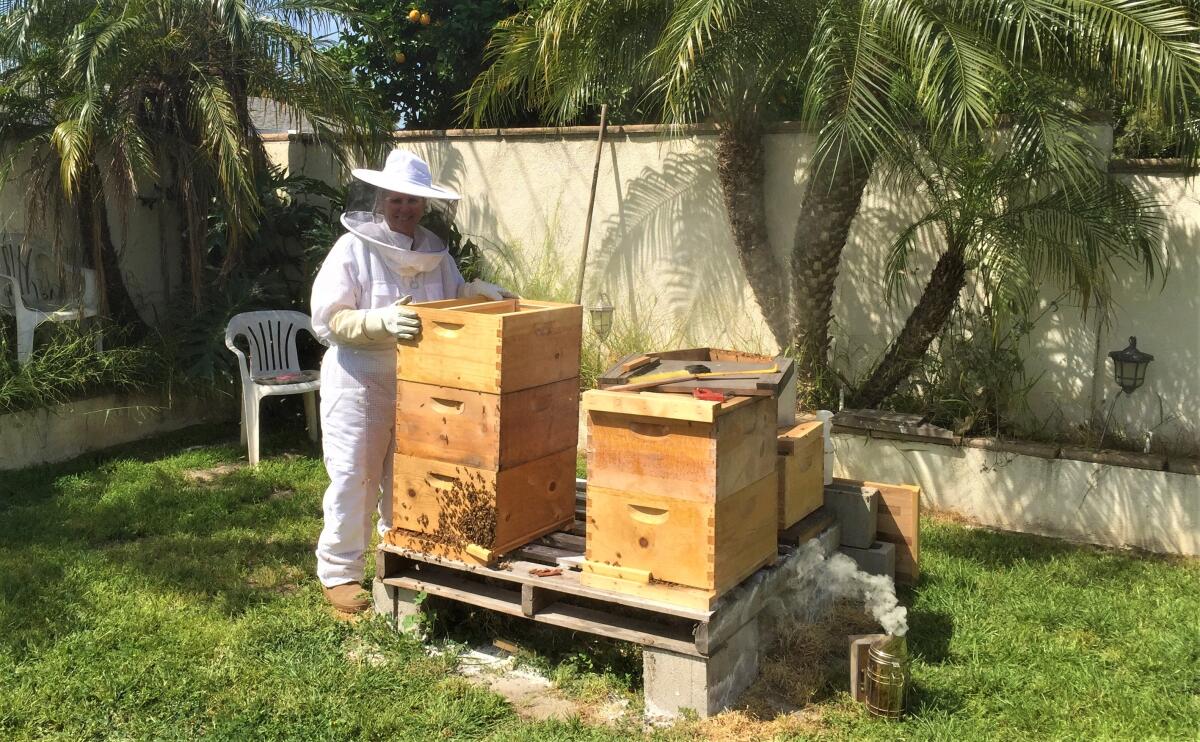Costa Mesa beekeeping law clears first review by City Council

- Share via
With a little refinement — and a lot of conversation among animal control officers, backyard hobbyists and environmentalists — Costa Mesa appears to have landed on a set of rules to legalize and regulate residential beekeeping.
City Council members Tuesday approved the first reading of an ordinance that would allow residents to apply for permits to keep and maintain hives for honeybees on their properties, after undergoing review and approval by city staff.
Staff would consider site plans and notify all adjacent neighbors, who would have 30 days to respond with questions or possible objections. The keepers of any currently unpermitted beehives would have 90 days to come into compliance with the rule, which would take effect after the draft law’s second reading by council.

Up to two hives would be allowed in a front yard, backyard or side yard, as long as they were at least 15 feet from a keeper’s property line and 25 feet from neighboring buildings, but could not be visible from the public right of way. If that distance can’t be maintained, a beekeeper must build a 6-foot wall or hedge around bee boxes to drive flight paths skyward.
City officials have not yet determined how much a beekeeping permit might cost but agreed to review and return with a fee resolution with amounts sufficient to recover staff time spent on implementation and enforcement of the new rules.
While most of the ordinance had already been hashed out by Costa Mesa Police Lt. Stephanie Selinske, who manages the city’s Animal Services Unit, a group of conservationists from the local nonprofit Coastal Corridor Alliance (CCA) appeared Tuesday with a special request.
Paul Waggoner, a community organizer for the CCA, said honeybees can become highly territorial and drive off native species of bees. They are also prone to starting feral colonies in places where they’re not particularly helpful.
City laws say it is illegal to keep bees outside of educational or scientific settings, but talk about drafting a law to legalize the practice is taking wing.
He asked the council to include information on native plants and pollinators to new permittees and consider creating a 1-mile buffer zone between residential hives and natural habitat open spaces, such as the city’s Fairview and Talbert parks, the Randall Preserve on Costa Mesa’s border with Newport Beach, and the Back Bay area.
“We just hope that we can find a way to do what we want as humans and also protect the natural world,” Wagonner said.
Sean Crowley, a commercial beekeeper and mentor to newcomers to the pursuit, advised the council to include some flexibility on the number of allowable bee boxes, so hives could be split in springtime, when bee populations can swell exponentially, to reduce aggressive swarming.
Councilman Manuel Chavez put forth a motion that conceded to Crowley’s point and also established a 500-foot distance requirement between home hives and the four named open space preserves.
Daily Pilot and TimesOC readers share their thoughts about local issues and events. This week we hear from readers in Costa Mesa, Los Alamitos and Huntington Beach.
“There’s a lot of restoration going on in Fairview Park, and a lot of work going on in the [Randall] Preserve in the next few years, and I want to have a buffer — not a big one, just a small one — to see if that helps with that process,” he said.
Bee enthusiasts like resident Alberta Mirisciotti, who runs the licensed bee rescue and relocation business Hey Honey, thanked the council for responding to residents’ requests for nearly three years to legalize beekeeping.
“Although the ordinance is probably never going to make everyone happy, I support it,” she said. “It’s something us beekeepers are willing to work with so we don’t have to go underground, and we can also support our environment in Costa Mesa.”
All the latest on Orange County from Orange County.
Get our free TimesOC newsletter.
You may occasionally receive promotional content from the Daily Pilot.






